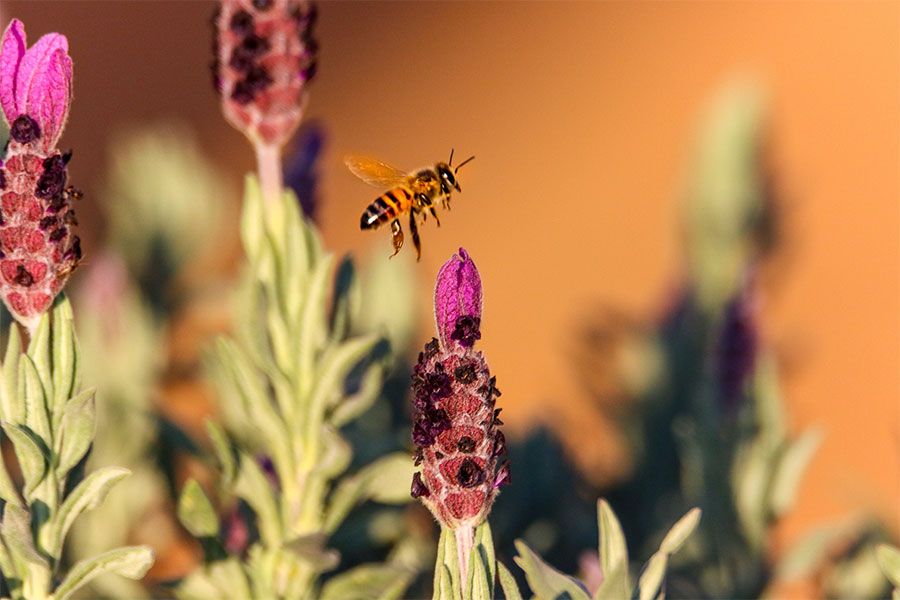Most of the sane world can agree that climate change is real, quantifiable, visible, and impactful. It affects weather patterns and causes extreme temperatures, droughts, floods, tornadoes, and hurricanes. Amid the political debates about climate change, the tangible ramifications of our changing environment cause death and destruction around the world. A not-so-visible sign, but one capable of causing an impact on a massive scale, involves the world’s food supply and a tiny insect mentioned by name in the Qur’an. Imagine — the fate of the humble honey bee intertwined with humans, the trustees of the Earth. If humans are the trustees, then honey bees are the loyal and tireless workers in the enterprise we call “nature.”
Worldwide, honey bees are one of over 20,000 different bee species including about 4,000 wild native bee species in North America. They are the primary pollinators for vegetation – 75 percent of nuts, vegetables, and fruits produced in the United States and more than 80 percent of flowering plants. Most of the honey bees today are domesticated; even the decreasing number of hives in the wild are mostly domesticated bees which have swarmed and established a new home. Swarming is the term used to describe the event when the hive becomes overcrowded and roughly half the bees leave the original colony with the queen after grooming a new queen for the original colony.
Honey bees are the most well-known species of bee and they pollinate crops as well as produce honey. All pollinators, including honey bees, account for pollinating the plants that provide one third of the world’s food supply and one half of the world’s fibers, raw materials, and oils. Many of those plants, in turn, are crucial to protect and feed wildlife, make medicines, prevent soil erosion, offset CO2 by producing oxygen, and clean waterways. While butterflies, moths, and other insects pollinate, what makes honey bees significant and indispensable are their numbers and efficiency – on average over 2,000 flowers can be pollinated in a single day by a single bee. Honey bees pollinate vegetation in the wild as well as in commercial pollination, with over 100 different crop types.
Honey bees and other pollinators, however, are affected by the same climate extremes which threaten our planet’s ecosystem. In addition, they are dying from insecticides sprayed on large fields and private yards. Their biodomes are also reduced by single-crop vegetation and property construction, taking away large swaths of land that would normally support wildflowers, trees, and other plants.
The number of bee colonies has drastically declined since 1947, from six million down to two and a half million in 2016. That is a 44-60 percent loss of domesticated bees in the U.S. alone. Wild or native bee pollination accounts for over $9 billion dollars in crops. Just in North America, over 4,000 wild bee species live solitary lives in all growing zones, in the Midwest grasslands, northwestern forests, and southwestern deserts. Sadly, they face the same harsh reality as honey bees and their numbers have seen significant decline as well. Globally, the loss of bee colonies is in the billions. Now, scientists are fearful that a new variant of a bee virus, the Deformed Wing Virus, carried by the varroa mite, could wipe out honey bees in the near future.
Dr. Robert Paxton, a professor at the Martin Luther University in Germany, is an expert on bee diseases and has a warning for the world, “Our lab research has shown that the new, highly contagious variant is killing bees faster.” The varroa mite lays eggs on bee pupa in their hives, killing them. Variants are already increasing and each new version spreads to another continent. Paxton emphasized that, “Bees are the most important creature for mankind and the environment.” According to Achim Steiner, Executive Director of the U.N. Environment Programme, “Human beings have fabricated the illusion that in the 21st century they have the technological prowess to be independent of nature. Bees underline the reality that we are more, not less, dependent on nature’s services in a world of close to 7 billion people.”
Protecting the Humble Honey Bee
In Surah An-Nahl, a chapter in the Qur’an titled “The Bee,” Allah describes the usefulness of the small insect: “And your Lord inspired the bee: ‘take habitations in the hills and in the trees and in that which they construct. Then eat of all fruits, and follow the ways of your Lord, made smooth.’ There comes forth from their bellies a drink diverse of hues, wherein is healing for mankind. Indeed, in that is surely a sign for people who reflect” (Qur’an 16:68-69). The bee has the God-given instinct to pollinate and provide sustenance and healing for Allah’s other creatures. The surah is a reminder of Allah’s favors, an exhortation to humans to live in a righteous way, and a warning of the consequences for rejecting Allah and His signs. This same surah explains that Allah also provided an’am (a collective term which includes cattle, camels, sheep, goats, and other domesticated animals) as sources of food, clothing, and other resources. Another verse describes the beasts of burden like horses and donkeys. Yet, those creatures that Allah has given to humanity for their usefulness are also dependent on the survival of the tiny bee. It is a clear lesson on the interdependence of nature. There are pollinators and there are decomposers like beetles, flies, etc. Both types are necessary for a balanced and sustainable ecosystem that includes new growth and decay, a food chain that transfers matter and energy, and the interplay of factors and conditions that support the survival of animals, plants, and other organisms.
Muslims can no longer afford to leave environmental stewardship to others. The Qur’an (30:41) admonishes and reminds Muslims over and over about the perils of ignoring His signs, “…So He may let them taste part of what they have done that perhaps they will return.” Open any news program at any time of day and there are active, climate-related disasters in the U.S. and the world. Bangladesh experiences floods almost yearly, droughts in African countries are on the rise, and the weather extremes across the U.S. have no end in sight.
The Qur’an explains that the Earth provides sustenance for the survival of the descendants of Adam. The Earth, however, is also the place where human beings are tested as to their beliefs, their willingness to submit to Allah, and their demonstration of moral rectitude. We should remember the following hadith: “Whosoever of you sees an evil, let him change it with his hand; and if he is not able to do so, then with his tongue; and if he is not able to do so, then with his heart — and that is the weakest of faith” (Sahih Muslim). There are many general environmental groups that one can join. If helping the bees recover is of interest to you, there are several groups: beesponsible.com; the bee conservancy; plt.org; and planet bee foundation. A Muslim organization from Singapore, Greenfitree.org, has actionable plans on living a green life, addressing things like personal water conservation and green iftars.
Every Muslim should know that humans are trustees (khulafah) of the Earth, but what does that mean in terms of personal responsibility? The Earth is a trust (amana) and if taken care of correctly by its trustees, through religious adherence and moral duty, there will be a sustainable balance of economic growth, environmental protection, and social responsibility. Today that means protecting the humble honey bee, if not on a grand scale, at least in your own backyard.





